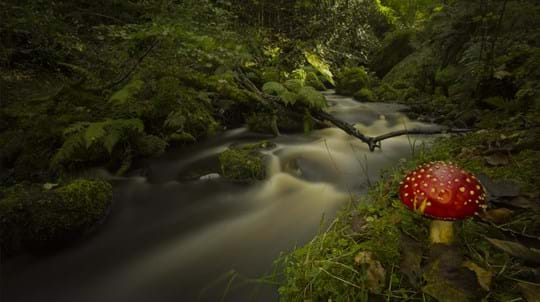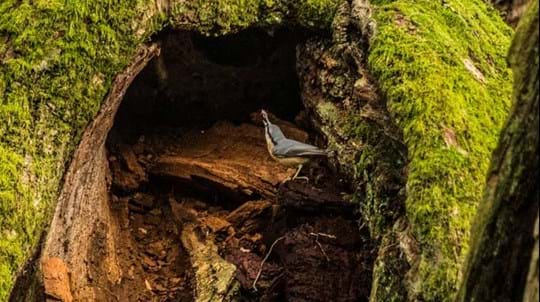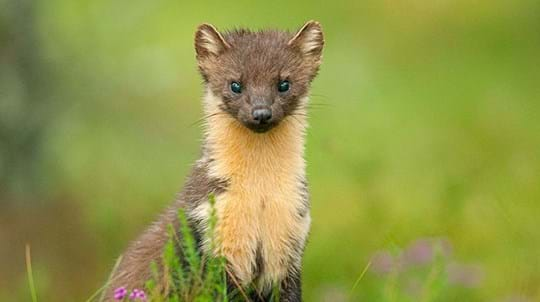Protect trees to protect bats
Your support will mean we can continue to plant trees and restore and protect habitats, providing bats with a place to live and forage, and much more.
Donate todayA staggering 75% of the UK's bat species rely on trees, woods, hedgerows and deadwood. All year-round.
Delve into why trees are important to bats, the specific tree features that are vital to the majority of these aerial acrobats, and how we take action to secure the wooded habitats that they rely on.
To avoid competing with each other, bats simply use woodland features in different ways. It is important to make woods as diverse as possible, so that they support a number of species.
Bats have diverse needs that woodland and hedgerows fulfil. Take a walk around a wood and you may see a mixture of habitats. Below the canopy of conifer and broadleaved trees, a shrubby understorey thrives alongside rides rich with varied vegetation and watercourses and ponds that are alive with insects. The canopy may give way to open glades, grassland and wildflower meadows, or envelope the occasional disused building or structure that some species rely on.
At dusk on a summer evening, you may see bats peeling away from their roosts and taking to the skies to find food – some travel over large distances. Look out for linear features like woodland edges, hedgerows and rivers that are important navigational landmarks and commuting corridors for species like the lesser horseshoe and greater horseshoe.
You might be lucky enough to see bats swooping as they hunt for insects – some species, like Daubenton’s bats, prefer waterways where they can also have a drink as they forage, while others prefer grassland or woodland. While most bats commute to different areas to feed, the elusive Bechstein's bat roosts and forages in woodland, and very rarely ventures further afield.
Come winter, bats will be hibernating within the hollows of trees or in old buildings and viaducts.
Your support will mean we can continue to plant trees and restore and protect habitats, providing bats with a place to live and forage, and much more.
Donate todayNext time you explore a woodland or hedgerow, take a look at the trees and you will soon see that they have plenty of nooks and crannies for bats to live, mate, hibernate and give birth in.
Bats are nocturnal mammals, so you're unlikely to see them during the day, but you may pass right by a hollow tree harbouring a noctule maternity colony of up to 200 individuals.
Oak, ash, beech, sycamore and Scots pine all play a role in supporting bats, with ancient and veteran trees being particularly sought after by these flying animals. Here are four tree features that help to support bats.

Credit: Tom Reed / WTML
Try and spot trees with plenty of hollows. Bats, like the nomadic barbastelle, often use these to live, mate, and give birth in. In winter, they will use these humid and frost-free areas for hibernation.

Credit: Steve Holroyd / Alamy Stock Photo
In spring, look out for cracks, splits, crevices, loose bark, or rot holes and woodpecker holes that may harbour roosting Bechstein's bats, soprano pipistrelles or Daubenton's bats.

Credit: Rohrspatz / Pixabay
Keep an eye out for ivy on trees. This plant is a valuable addition to habitats – it provides food to insects - acting like a larder that's full of tasty treats for bats! It's also a great place to roost.

Credit: Michelle Howell / Alamy Stock Photo
Look up into the canopy to see sheltered branches that give bats protection during bad weather, and also act as feeding perches while bats are out and about foraging.
Bechstein’s bats are also among Britain’s rarest mammals, confined to a few ancient woods in the south of England.
Bat populations have fallen dramatically in the past few decades due to habitat destruction and loss of prey. We aim to increase roosting opportunities, improve foraging areas and boost insect numbers, by protecting, restoring and managing trees, woodland and hedgerows.
When woods and trees face challenges, the bats that depend on them also suffer. They lose their roosting sites, hunting grounds and navigational landmarks. Individuals may not be able to find breeding partners and the community as a whole may be vulnerable to a lack of resources and disease.
We encourage the natural cycle of establishment, growth and aging of habitats, while campaigning to safeguard our precious ancient woodlands and trees against developments and threats, like HS2 and pests and diseases. To help stabilise and boost populations of bats we:
If you are interested in bats, look out for them at dusk. Our woods support a range of species, with Pressmennan Wood, Parc Mawr and Duncliffe Wood being hot spots for these insectivores. You can encourage bats too by making your garden bat-friendly.

Your support will mean we can continue to plant trees and restore and protect habitats, providing bats with a place to live and forage, and much more.
Donate todayLearn more about how trees support thousands of species

Trees woods and wildlife
Woodland is home to a wealth of wildlife. If we don't protect what we have left and plant trees for the future, we'll lose more than just trees.

Trees woods and wildlife
Our fantastic oaks support more life than any other UK native tree. Discover which species live and feed on oak, from foxes and fungi to bats and beetles.

Trees woods and wildlife
Woods and trees are home to more wildlife than any other landscape, providing homes for thousands of species including our most loved animals.